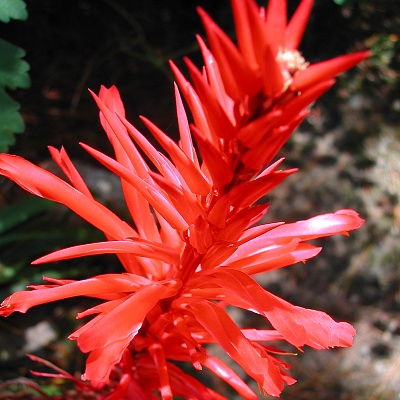Germinating the seeds
Plant your seeds when you receive them for best germination Getting started -- You may use small pots or cups with drainage holes that are about 2-3 inches tall (5-7 cm). For soil, use a well draining
mix. I use a mix of 1 part
coco fiber Fill the pots with soil and sprinkle a few seeds on the surface. An easy way to pick them up is to breathe on your finger tip and then quickly dab the seeds. Plant them at least 1/4 inch (6 mm) apart. If you have
long-fibered sphagnum moss Until the seeds sprout, ensure that the surface soil always stays moist. A plastic dome or bag may be used to maintain near-100% humidity, but leave it open a crack to allow some fresh air in. You may need to drip a few drops of water over the seeds every day to keep the seeds moist. The ideal temperature for germination is between 65 to 77 degrees F (18-25°C). A little cooler at night is ok.
Avoid letting them get above 80° F (27°C) for prolonged periods. I recommend placing a
minimum/maximum thermometer Keep them in bright light out of
direct sun. A bright LED or fluorescent bulb kept 4 inches (10 cm) away provides
the right amount of light (See: "Growing indoors with LED lights").
Fertilizing -- The first 2
months, feed weekly
with a small amount of dilute (1/8 strength) liquid fertilizer.
Hydroponic fertilizer
is ideal for seedlings, because it is easily absorbed and contains all essential
nutrients. After 2 months, you may switch to a granular fertilizer Growing onward... Climate -- Pitcairnia ringens comes from about 3000 to 7000 feet elevation in Mexico, where temperatures are a bit cooler than the lowlands. I know it can handle temperatures in the mid-80s (30°C), but i have no information on how it will do in warmer conditions, so consider it experimental in warmer climates like Florida and Texas. In warmer climates, i would use an oversized pot to keep the roots cooler. The underground rhizomes can probably handle at least a few degrees of frost, although i recommend protecting the plant from all frost. Lighting -- The plant has flowered both in full sun and in full shade, but it seems to be happiest with about 50% sun. Some afternoon shade might be needed in warmer areas. Transplanting -- When your plants are about 2-3 months old, you may gently transfer them to larger pots, using a similar soil mix as mentioned earlier. Avoid strong sun for 2 weeks after repotting. At 1 year old, they will need a pot approximately 1 gallon (4 liter) in size, which should hold them for a year or more. You may separate any offsets if you wish, but this might delay flowering. They generally aren't
bothered by insects, but watch for any pests that can affect your other
plants. - Jeff Strange Wonderful Things
|
|||||||||


